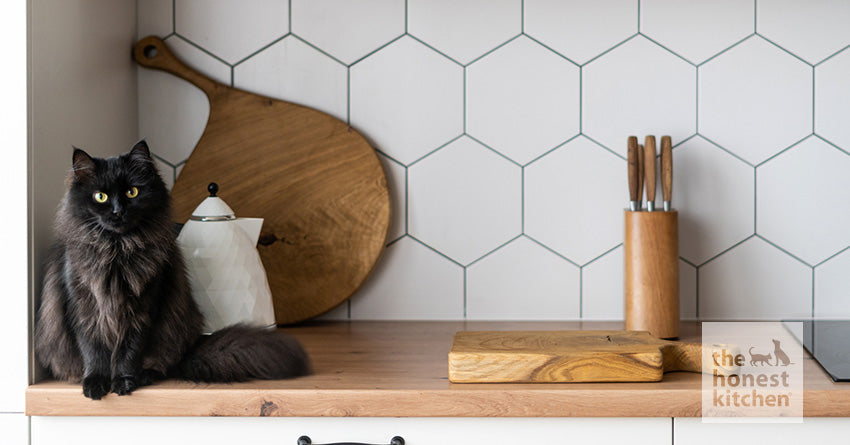Many cat owners who want the best for their cats find themselves looking for cat food recipes they can cook at home. They are under the impression that cooking their own cat food is the healthiest way to feed their pet. However, commercially produced cat food products are the best option for most cats.
Store-bought cat foods are formulated specifically to meet cats' complex nutritional profiles — something that is very difficult to recreate in a home kitchen without expert guidance from a veterinary nutritionist.
But, in moderation, you can use DIY cat food recipes as a supplement to your cat’s other food as a healthy topper. Read on to see how you can safely feed your cat food that you made at home!
The Importance of Feeding Cats a Balanced Diet
Changing up your cat’s diet with occasional homemade treats can help keep them interested in mealtime and provide a greater variety of nutrients. However, before you feed your cat homemade pet food, make sure you understand the importance of providing your beloved pet with a balanced diet.
Most homemade cat food recipes rarely have the right balance of vitamins and minerals to meet your cat’s nutritional needs. As a result, they shouldn't make up the majority of your cat's diet but can be an excellent treat for special occasions.
In one 2019 study, researchers looked at 114 recipes found online and in print books for homemade cat food and analyzed their nutritional adequacy. Here's what they found:
- Only 94 recipes (82%) had enough information to perform a nutritional analysis.
- None of those 94 recipes had the recommended daily allowances for an adult cat’s diet.
- Forty percent of the recipes didn’t provide feeding instructions, such as serving size.
- Seven percent of the recipes contained potentially toxic ingredients.
This study illustrates how making your own cat food can be harmful — whether you're risking nutritional deficits or, worse, harmful ingredients. To combat this and ensure your cat has a balanced diet, you should only give homemade pet food as an occasional supplement to high-quality commercially prepared cat food (which should make up the bulk of their daily intake).
Best Proteins for Natural Cat Food Recipes
If you do opt to serve your cat the occasional homemade treat, make sure you choose a high-quality protein as the main ingredient. Proteins are an important source of the amino acids (like taurine) a cat needs to build and maintain muscle tone, but not all protein sources are created equal. Be sure to opt for high-quality muscle and organ meats.
Here are three great choices to get you started.
Beef
Beef is a good protein choice for a healthy cat treat or supplement because it's full of vitamins. Specifically, it has high levels of iron, phosphorus, and zinc. It also has b-complex vitamins, including vitamin B12 and vitamin B6. These support the digestive tract, nervous system, and immune system.
Chicken
Chicken is another quality protein source for a healthy cat. It's lean, low-calorie meat, which can reduce the risk of obesity. It’s also considered easy to digest. Chicken organ meats, like chicken liver, are particularly nutritious options. If you choose another cut of chicken, choose boneless cuts to avoid the potential risk of bones that may splinter while your cat is eating them.
Chicken has high levels of omega-6, which supports the skin and coat. It also has selenium, vitamin B6, and phosphorus, which can support the bones, liver, and nervous system.
Salmon
Salmon is rich in omega-3 fatty acids, potassium, b-vitamins, and niacin. However, it's important to note that cats that consume too much fish can develop kidney disease due to vitamin K synthesis problems. You'll find salmon to be a popular ingredient in many commercially made cat food recipes due to its nutritional density, but it's balanced with other ingredients to prevent over-intake.
How to Safely Prepare Meats for Natural Cat Food Recipes
Safe food handling is essential when preparing food for your feline friend. While you’ll be giving up unnecessary preservatives if you prepare your own supplemental food at home, you don’t want to trade this problem for a more damaging one by handling the food unsafely.
First, make sure you thoroughly cook any protein you use. Raw meat — especially raw chicken — is at higher risk for salmonella and other foodborne illnesses. Boiling meat is usually a good way to ensure it's fully cooked.
If you want to make it easier to eat, send it through a food processor or meat grinder with some water or unseasoned broth to create a food that’s similar in consistency to commercially prepared wet cat food. Alternatively, putting meat in a slow cooker with some broth can also give the meat a very tender texture that’s easy for cats to chew and digest. It’s important to use a pet-safe bone broth, rather than one found at a grocery store, as broths for humans typically have additional seasonings and ingredients that can be potentially harmful to your cat.
As you prepare meat for your cat, avoid seasonings: Your cat doesn’t need them, and they can be dangerous. Seasonings like garlic or onion are potentially toxic. Your cat doesn't need the flavor you expect from meat, and seasonings add no nutritional value.
Other Natural Cat Food Ingredients To Consider
Cats are obligate carnivores, but since they don’t eat the full prey animal in captivity, they still need some carbohydrates. As you look for natural cat recipes to try as treats for your cat, consider some that incorporate these natural ingredients.
Broccoli
Broccoli is not only safe for cats, but it’s also quite healthy. The carotenoids, fiber, and vitamin C in broccoli are all essential nutrients. It also has antioxidants that can provide an immune system boost. This can be served raw or lightly steamed.
Peas
Peas are considered one of the safest human foods to feed a cat. While you always need to watch for sensitivities, they’re rare with this vegetable. Peas are loaded with vitamin B, vitamin K, and vitamin C and are a great source of iron, copper, and potassium.
Cucumbers
Cucumbers are 95% water, so this vegetable is a great way to provide a little extra hydration for your cat. It also has vitamin K, vitamin C, beta carotene, and potassium, so it is a nutrient-rich food to add to your cat’s diet. Keep in mind that most of the nutrients are in the peel and seeds, so keep the peel on when feeding your cat this nutritious food.
Plain Greek Yogurt, Kefir or Cottage Cheese
These ingredients contain calcium, phosphorus and other nutrients that your cat needs. Plain yogurt and kefir are also a great source of probiotics to help with digestion. Just be sure that you opt for options without added sweeteners (like xanthan gum) that are toxic to pets.
Cooking and Preparation Tips for Cat Food Recipes
As you consider feeding your cat a homemade recipe, ensure you’re doing so safely. Here are a few tips to help you avoid common mistakes pet owners make when cooking for their cats.
Understand the Risks of Feeding Your Cat an Unbalanced Diet
Relying on a completely homemade diet makes meeting your cat’s full nutritional needs nearly impossible. A commercial diet is the best way to get the right nutrient balance for your cat. Talk to a veterinary nutritionist about the nutrients your cat needs every day, and then choose a high-quality commercial cat food that aligns with those requirements.
Additionally, if you plan to feed home cooked foods as a topper to your cat’s formulated food, remember to do so in moderation to ensure your cat isn’t overeating.
Clean Areas Thoroughly When Cooking for Cats
Practice good kitchen cleaning techniques when cooking for cats. You don’t want to expose your cat to toxic foods and spices, nor do you want to risk any contamination from raw meats that you had prepped in the kitchen and failed to clean properly.
Our 2 Favorite Cat Food Recipes
If you want a more-involved recipe that uses human food ingredients as a topper to your cat’s normal meal, we’ve included two of our favorites below. Please note, these are not meant to replace a complete and balanced diet for your cat.
1) Sardine Salad
Sardine Salad works great as a topper for any nutritionally balanced pet food. It has the essential fatty acids found in fish oil, and green beans and cantaloupe provide a source of carbs, fiber, and vitamins. Best of all, the prep time on this recipe is just a few minutes!
Check out our Sardine Salad recipe for cats and dogs.
2) Simple Butternut Squash Soup
Mix some butternut squash with The Honest Kitchen's Beef Bone Broth for a savory fall treat. Pour it over your cat’s regular food, or give them a bowl to lap up as a special treat. This recipe is quite simple, but the butternut squash adds a boost of calcium, magnesium, vitamin A, and vitamin B6.
Try our Simple Butternut Squash Soup recipe.
Try a Human Grade Cat Food From The Honest Kitchen
While cooking for your cat can be fun, making your own cat food is unnecessary if you can find complete and balanced prepared cat food that is made with only healthy, wholesome ingredients and isn’t loaded down with fillers, feed grade by-products and other unsavory ingredients.
The Honest Kitchen develops our human grade recipes for cats with help from veterinary nutritionists, and we use human grade ingredients to provide a quality product with a great taste that cats love. We use only thoughtfully sourced, high-quality proteins in all of our recipes, and the foods include the right balance of nutrients to help support a healthy cat.
If you are interested in adding human grade cat food to your cat’s diet, browse The Honest Kitchen's collection of high quality cat food for adult cats.
*Health Disclaimer: This post is educational in nature and doesn’t constitute health advice. Please consult your pet's veterinarian or other healthcare professional for specific guidance on this topic.

